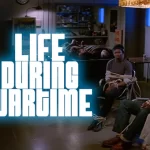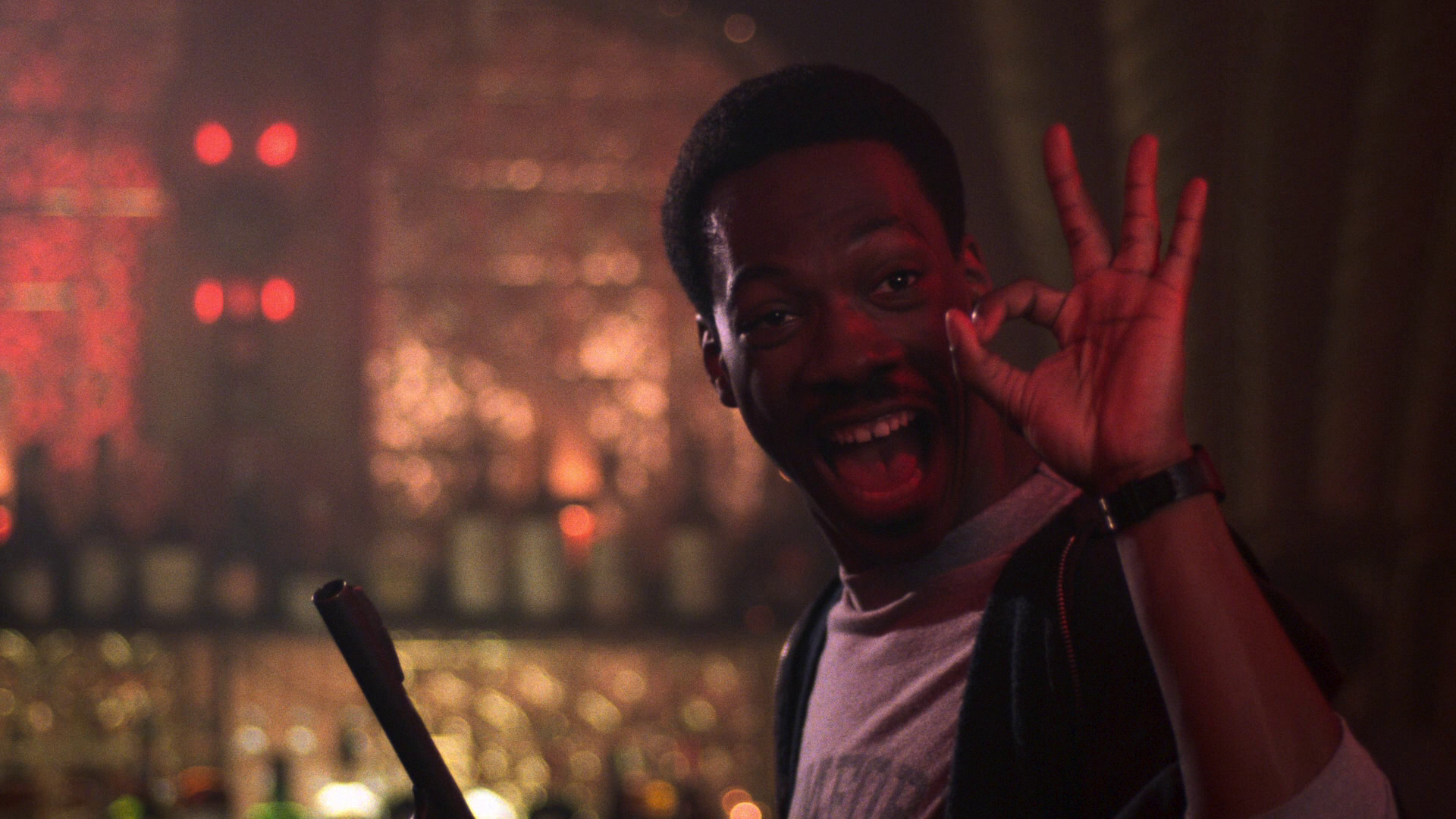Note: all framegrabs were sourced from the 4K UHD disc
***½/****
DVD – Image B- Sound B Extras C
4K UHD – Image B Sound A- Extras C+
starring Gregory Peck, Audrey Hepburn, Eddie Albert, Hartley Power
screenplay by Ian McLellan Hunter and John Dighton
directed by William Wyler
by Walter Chaw It’s one of those seminal moments that movies provide the culture with now and again, like the swoop up a little rise to an impossibly fresh John Wayne in Stagecoach, or the intervention of a fortuitous steam vent in The Seven Year Itch, this introduction we have to Audrey Hepburn as she’s whirled around in a barber chair in William Wyler’s Roman Holiday to reveal the pixie-cut heard ’round the world. That she’s adorable is a given–the real issue is whether she’s an actress or just a bundle of inexplicable charisma, a ganglion of celluloid starlight that evaporates under the slightest critical scrutiny. I love Roman Holiday, but I vacillate between indifference and actual dislike of the rest of Hepburn’s films. I don’t find her winsome in Breakfast at Tiffany’s, am irritated by her in Charade, think she’s appallingly twee in Love in the Afternoon. She doesn’t hold her own against Sean Connery in Robin and Marian and gets blown off the screen by Albert Finney, Alan Arkin, and Rex Harrison in Two for the Road, Wait Until Dark, and My Fair Lady, respectively. If you ask me, Audrey isn’t an actress so much as someone you would like to have known and maybe had the opportunity to cuddle, which makes her mega-stardom in the Fifties and Sixties all the more testament to her ineffable appeal. Happening right when Method was rendering personalities like Hepburn déclassé, she was making a career of being terminally anachronistic. It’s Ozzie’s Harriet, sashaying while Rome burns. Instant nostalgia; even when she was introduced for the first time, it must have seemed like ages ago.
The story of her discovery the stuff of legend, from the awkward screen test to the initial refusal of a stage name, Hepburn in Roman Holiday is bratty Princess Ann, a monarch in 1953 who wants to throw off the chains of domesticity in the City of the Seven Hills. She sneaks away from her handlers in high Prince/Pauper style and into the bed–platonically–of handsome, hapless journalist Joe (Gregory Peck, thirteen years Hepburn’s senior; more on this later), who, once he’s figured out who he has between his sheets, decides to indulge her charade in hopes of landing the mother of all scoops. Along for the ride is paparrazo Irving (Eddie Albert, never better), contributing the lion’s share of physical gags and masculine bonhomie as he and Joe–the elder statesmen, as it were–play the young princess for a fool. Lucky for her, Joe falls in love before he can well and truly punish her for her innocence. Roman Holiday introduces the Hepburn persona as one whose brightness and naivety lead to inevitable exploitation and abuse, although because she’s so goddamned irrepressible, she eventually triumphs on the strength of her intimidating pluck. Hepburn’s films tend to have her drunk on ether, walking on clouds, sobbing wretchedly, and then summoning courage–a little sadder, perhaps, because that’s the only way we can suffer her continued existence. (Those seeking a template for Sally Hawkins’s awesome performance in Mike Leigh’s Happy-Go-Lucky, look no farther than the high concept of an Audrey Hepburn character plopped down in the real world.) The reason Roman Holiday works is because it understands Hepburn’s place in the pantheon of Silver Screen icons: she’s a Vestal Virgin, stoker of the sacred fire, punished with death by scourging should she–or anyone–sully her position through inattention or defilement.
Anyone who cares to know already knows that Roman Holiday, one of the most documented of films, was shot on location, that the moped and Mouth of Truth scenes were improvised, and that Peck insisted on sharing top-billing with Hepburn, so unerring was his intuition that she would be a phenomenon. What’s less easy to quantify is a chemistry between Hepburn, Peck, and Albert that justifies the title’s breezy promise, or the audience’s identification with a young woman in that tumult of the early-Fifties who, at least for a while, rejects the responsibilities of a traditional role for the hope of a life lived in the pursuit of tiny victories won in the name of individuality and love. There’s real joy in Hepburn’s performance, and the extent to which stony Peck comes to life in her company is just this side of miraculous. Good thing Cary Grant turned down the role: him doing “in love” is rarely anything but reptilian and sardonic.
THE DVD – CENTENNIAL COLLECTIONParamount revives Roman Holiday and the original Sabrina on DVD in handsome, slipcovered Centennial Editions that would look great on my shelf, I’m sure, if I had a complete set of spine numbers (these are #s 2 and 3, for those keeping score). Roman Holiday receives a fresh encode in lip-smacking 1.33:1 fullscreen, toning down any compression issues that were inherent in the previous edition. The DD 2.0 mono audio is similarly crisp and presented without frills or argument. A very slight (4-page) insert booklet with brief notes in the style of TCM’s “Why it’s Essential” shares space with two discs in a regular-sized plastic keepcase. The first platter contains the movie proper along with a colorized (!) trailer for It’s a Wonderful Life, reserving the second for a surprisingly sparse collection of extras. “Restoring Roman Holiday” (7 mins.) is what it is and not nearly as illuminating as a pair of docs jettisoned from the picture’s prior release on the format, replacing them with “Audrey Hepburn: The Paramount Years” (30 mins.). Doing the basics on the legend in hagiography form, it dwells overlong, methinks, on her loyalty to poor designer Givenchy, robbed by Edith Head and the studio system but Hepburn’s clothier forever after. Yawn. “Rome with a Princess” (9 mins.) revisits a few locations from the shoot, while the real meat is reserved for “Dalton Trumbo: From A-List to Blacklist” (12 mins.), a piece that goes into some gratifying depth on the toll and outrage of Hollywood’s darkest period. “Behind the Gates: Costumes” (5 mins.) and “Paramount in the 50s” (10 mins.) are self-aggrandizing horseshit documentaries no doubt chiefly intended to hawk the rest of the films upcoming in this round of reissues. A stills gallery fills out the presentation. Excerpted from a longer review originally published June 18, 2010.
by Bill Chambers I had perhaps baselessly high expectations for Paramount’s 4K upgrade of Roman Holiday, just because the movie’s picture quality has improved with each new reissue and because black-and-white lends itself to the UHD format, even without the advantage of the wider colour gamut. Alas, the original negative was badly damaged during production in Italy and had to be practically lacquered in tape just to get through the printing process. When a dupe negative was struck from this flawed source, it was optically magnified to crop out the most visible splices. Under the 4K microscope, Roman Holiday looks, well, blown-up: pervasively soft-edged, with only the film grain coming into clearer focus. Some of the Old World scenery has a bit more textural interest/impact than it does in the 1080p alternative, yet there remains a sort of ghostly remove between the film and the viewer. I was surprised and, if I’m being honest, a touch disappointed that Paramount didn’t do more to boost the highlights with HDR and thus better evoke, even restore, a sense of immersion in the characters’ day, though I audited the image in HDR10–the 1.37:1, 2160p transfer also includes Dolby Vision, which might well improve things in this area. (How I kept wanting, in a tactile way, the sunlight to catch Peck’s collar, to cheekily glint off Irving’s lens.) For what it’s worth, I felt the bitrate could be higher to minimize any collateral loss of detail, as it tends to peak around 50 Mbps.
Ported over from the BD, the attendant 2.0/16-bit Dolby TrueHD mono audio is rudimentary but crisp, responds well to amplification, and features persuasive acoustics, especially in the climactic press conference. This is another catalogue favourite that probably peaked with Blu-ray, and anything else is gilding the lily. But I suppose if you don’t already own Roman Holiday, you may as well start with this release. The disc comes packaged with the 2020 Blu-ray containing all of the extras Walter covered in his review (minus the colorized It’s a Wonderful Life trailer), along with the featurette exclusive “Filmmaker Focus: Leonard Maltin on Roman Holiday” (7 mins., HD). “Filmmaker focus,” in this case, refers to Maltin’s expertise in the cinema of Roman Holiday director William Wyler, who we learn was notorious for shooting numerous takes in search of that special something he couldn’t articulate. Maltin says that Wyler fought to make the picture on location in Rome and that Gregory Peck signed on with no female lead in place because he was desperate to do a comedy. (He cites the Mouth of Truth gag as one Peck stole from Red Skelton.) Wyler, of course, discovered Audrey Hepburn and the rest is history, but I like that Maltin turns our attention to a pre-“Green Acres” Eddie Albert, charming as hell in the role of Peck’s photographer buddy. U.S. copies are further supplemented with a digital code.
- DVD – 118 minutes; NR; 1.33:1; English DD 2.0 (Mono), French DD 2.0 (Mono), Spanish DD 2.0 (Mono); CC; English, French, Spanish subtitles; DVD-9 + DVD-5; Region One; Paramount
- 4K UHD/BLU-RAY – 118 minutes; NR; UHD: 1.37:1 (2160p/MPEG-H), BD: 1.37:1 (1080p/MPEG-4); UHD: English 2.0 Dolby TrueHD (Mono), French DD 2.0 (Mono), German DD 2.0 (Mono), Japanese DD 2.0 (Mono), BD; English 2.0 Dolby TrueHD (Mono), French DD 2.0 (Mono), Spanish DD 2.0 (Mono), Italian DD 2.0 (Mono), German DD 2.0 (Mono), Japanese DD 2.0 (Mono); UHD: English, English SDH, French, German, Czech, Korean, Japanese subtitles, BD: English, English SDH, French, Spanish, Italian, German, Danish, Dutch, Norwegian, Finnish, Swedish, Thai, Korean, Japanese subtitles; BD-66 + BD-50; Region-free; Paramount



![Roman Holiday [4K UHD]](https://m.media-amazon.com/images/I/61ehckfo2FL._SL500_.jpg)



![Ben-Hur (1959) [Fiftieth Anniversary Limited Edition] - Blu-ray Disc|[Fiftieth Anniversary] Blu-ray Disc benhur](https://filmfreakcentral.net/wp-content/uploads/2011/11/benhur-150x150.jpg)